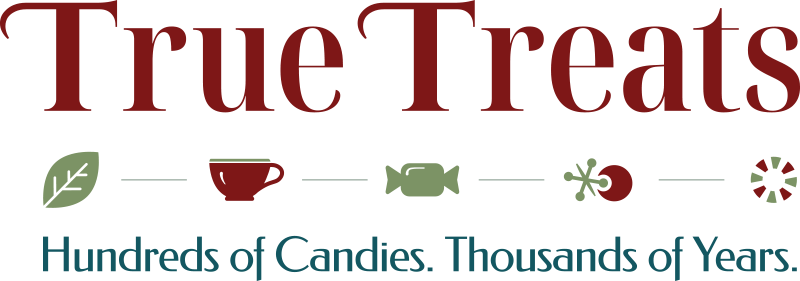Susan Benjamin is founder of Harpers Ferry-based True Treats Historic candy at truetreatscandy.com.
Free Shipping on Orders over $49 (Retail Only)
Shop Now
Follow link to read and watch about the only historic candy shop in the nation! https://www.voanews.com/a/us-candy-store-has-sweets-that-go-back-to-the-past-/4240725.html
Valentine’s Day sweets are older and more remarkable than taste reveals, some originating thousands of years ago to celebrations of fertility and sex. One example is the quintessential heart-shaped candy box.
The heart shape, which obviously looks nothing like an actual heart, likely evolved from the now extinct silphium plant used by fifth century Romans as a seasoning, medicine and birth control measure. Its pod was heart-shaped, lending itself to the symbolic heart of today.
After appearing in everything from 14th and 15th century artwork to16th century playing cards, it found a place in Valentine’s Day sweets in 1861. That’s when Richard Cadbury, of England’s Cadbury family, one of the world’s preeminent chocolate makers, invented the heart-shaped candy box.
As for its contents: enrobed chocolates, whether stuffed with cherries, caramels, or nougat, were all the rage for turn-of-century suitors. They were more than a gift of love – they were a gift of sex, or hopes for sex, anyway. Even plain chocolate was sexualized by rose-shaped and other molds.
The more romantic, Conversation Hearts evolved from a machine pharmacist Oliver Chase developed in 1847 to cut pills (and candy) in predictable slices. The result was the NECCO Wafer. About 20 years later, his brother Daniel made a machine to stamp sayings on the candy, then called “wedding candy.” The messages shrunk and the candy morphed into today’s Valentine’s Day classics.

Perhaps the most innocent of the Valentine’s Day line-up are the hard candies – whether the heart-shaped lollipops or the ornate balls placed in decorative packaging. These resulted from the boiled sugars – used simultaneously as medicines and treats. They found a home in grandmothers’ purses and candy bowls of the mid-1900s and remain a symbol of love today.

As for the gummies, jellies, and other sweets that have had a welcome invasion into Valentine’s Day gift-giving. These are as commercial as Valentine’s Day itself, as food-makers morphed their everyday treats into Valentine’s Day specialties, always welcome and, for the most part, in good taste.
When it comes to food research, I generally focus on sugars and sweets. But a recent lunch with a friend, Judy, convinced me to venture away. She and I met in Rockville, Maryland at the Sichuan Jin River restaurant, situated in an old style (think 1950s) shopping mall-ish place, between a vast parking lot and a busy street.
The restaurant lacked dazzle and the menu was full of common, crowd-pleasing items such as wonton soup. Fortunately, Judy, who has mastered the art of eating, selected satisfyingly Sichuan-style dishes for both of us: roasted peanuts with tiny anchovies, emboldened by chili peppers; beef tendons, softly spicy with a chewy textural edge; crisp lotus root; tea smoked duck; and seafood soup, sea creatures rising from the pallid broth.
For me, the flavors were unexpected yet familiar. After some thought later, I realized why. But first a word about Sichuan.
A Bit about Sichuan
Located in the Southwestern part of China, Sichuan is the second largest province in China, often referred to as the “heavenly country” for its remarkable natural resources. Its food likely dates back to the Qin and Han dynasties (221BC-220AD) and hinges on a balance of seven flavors: sour, pungent, sweet, bitter, aromatic, salty and hot, which Sichuan residents believe reduces internal dampness resulting from the area’s hot, humid climate. Increasingly, Sichuan food has become equated with heat and the cuisine has adapted accordingly, some blisteringly so.
It’s worth noting that UNESCO designated Sichuan’s 2,300 year old capital, Changdu, a “City of Gastronomy,” stating that it brings together rural and urban Chinese cooking as well as international influences.
From Sichuan to Wondering Jew
So why was the lunch new yet familiar? The answer is embedded in the DNA of the food itself: a remarkable encoding of history blended with the commonplace.
The peanut, for example, originated in South America where it was eaten by the Mayas of the Yucatan, the Incas of Peru, and tribes throughout Brazil. In the 1500s, the Conquistadors carried it to Europe and Asia and the Portuguese to West Africa. Later, slave traders loaded it on ships destined for North America. There the peanut was primarily eaten by enslaved people on plantations with limited options, until after the Civil War. Then, in rapid pace, its reach went from inexpensive candy brittles and bars and cooking oils to grand cuisine.
The chili pepper, with its signature bite, had a similar global route. Inhabitants of Mexico started eating them around 7000 BCE and cultivating them around 4,000 years later. In the 16th century, the Portuguese brought chili peppers to Africa and India. From there history gets murky: either Indian missionaries brought them to China along the Silk Route or Chinese merchants got them from Portuguese and Spanish sailors. Or, of course, both and then some.
Ironically, the China-based wonton, which I dismissed as banal and inconsequential, is actually an early – perhaps the earliest – dumpling. Its offspring includes Italian pasta (think ravioli and spaghetti) as well as the Russian pelmeni (Siberian dumplings with a variety of fillings), Spanish empanadas, Jamaican meat patties, British sausage rolls, and Jewish kreplach.
For Jews in medieval ghettos, the dumpling served another purpose: it enabled them to extend the use of hard-to-find kosher meat by wrapping discreet portions in dough. The Jews were likely carriers of the dumpling, as well: the quintessential wondering Jew, whether traders or migrant outcasts, were conduits for culinary cross-breeding, their range reaching from England to China to South America and places in-between.
And therein lies the heart of the familiar aspect of Sichuan food. The flavors spring from my personal experience as an American growing up eating peanuts, chili and pasta. But, I am also Jewish, and at least some aspects of Sichuan food is encoded in my own DNA, the untold generations of wondering Jews who directly or indirectly participated in Chinese culinary heritage.
It’s Inevitable, but Is It Good?
There’s no question that food propagation is as inevitable as the shifts in populations and the demands of taste. Inevitable, yes, but is it good? At least some chefs in Changdu think not. They worry that the recent bombardment of spice in their cuisine is burning out the nuances of flavor and, with it, scorching away their history.
In response, a band of retired chefs formed the Sichuan Old Chef Traditional Artistry Society to protect their time-honored past. Yet, this past is only a few centuries old – possibly less. What came before was certainly a milder, chili-free version of today’s food. The seafood that Judy and I found in our soup was unlikely, as Sichuan is a landlocked in a mountainous region. And the ubiquitous peanut didn’t exist.
So, are these changes good or bad? Perhaps the answer is balance, like the balancing of the seven Sichuan spices. One foot in the past for stability while the other foot wildly casts into the future.
The Tears of Mark: An Epilogue
By the end of lunch with Judy, and for days later, I found myself thinking about a Chinese journalist I had known, named Won. Won was part of China’s Democracy movement of the ‘80s, where Chinese students, journalists, and many others, demanded democratic change. The death knell came at the Tiananmen Square protests in 1989 where the Chinese government mowed down activists, sprayed them with bullets, imprisoned and tortured them. Won escaped with the help of a friend who worked in a government office and secured a false passport for him.
Once in the U.S., Won needed a place to stay that was off the radar of the Chinese secret police but accommodating and supportive. At the time, I was a writer, living in an artist colony in Boston. A journalist friend arranged for Won to live with me there, using my kitchen, food, and bathroom, while sleeping in the upstairs “dome”: a bed large enough to sleep 20 with a dome above it giving view to the sky or, as he probably saw it, the heavens.
In exchange Won would cook for me, making authentic Sichuan food. This was in no way a cultural exchange situation: he had no money, nowhere to go, and no way else to repay me. Eventually, he and others like him, received lifelong sanctuary from the Bush administration. He moved to Atlanta, changed his name to “Mark,” married, had a kid, bought a house, and, last I saw him, worked for IBM.
What I remember most, though, is coming home from work and finding Won in my kitchen, cooking for both of us, the air so saturated with smoldering spice I literally couldn’t breathe. Won was standing there welcoming me in the haze, a large spoon in his hand, happy while tears from the intensity of the spice were streaming down his face.
Where to Go
If you happen to be in the D.C. area,
here’s where you can find Sichuan
Jin River:
Sichuan Jin River
410 Hungerford Dr
Rockville, MD 20850
Sources:
http://unesdoc.unesco.org/images/0019/001920/192047E.pdf
Oxford Companion to Food, Alan Davidson [Oxford University Press:Oxford] 2nd edition, 2007 (p. 171)
https://www.thespruce.com/origins-of-spicy-szechuan-cuisine-695230
Cambridge World History of Food, Kenneth F. Kiple & Kriemhild Conee Ornelas [Cambridge University Press:Cambridge], Volume One, 2000 (p. 282)
“Stuffed Dumplings: The Get Around,” Craig Claiborne, The New York Times, February 10, 1982 (p. C1)
https://www.nytimes.com/2016/06/15/dining/chinese-food-sichuan-chengdu.html